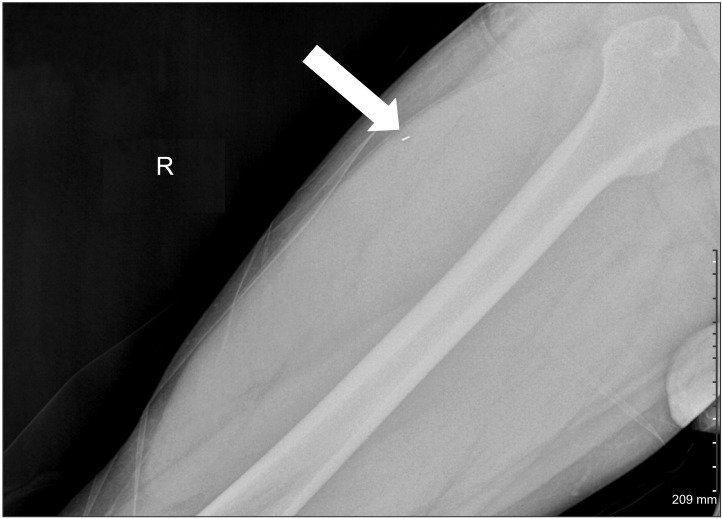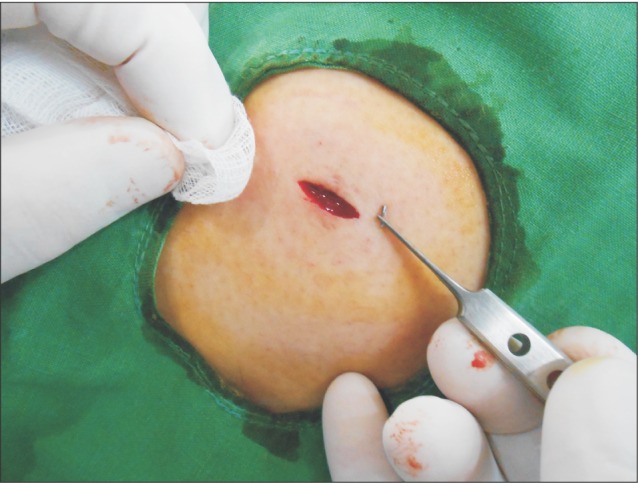J Korean Assoc Oral Maxillofac Surg.
2015 Oct;41(5):281-283. 10.5125/jkaoms.2015.41.5.281.
Percutaneous self-injury to the femoral region caused by bur breakage during surgical extraction of a patient's impacted third molar
- Affiliations
-
- 1Department of Oral and Maxillofacial Surgery, Daejeon Dental Hospital, Wonkwang University College of Dentistry, Daejeon, Korea. bck@wku.ac.kr
- 2Wonkwang Bone Regeneration Research Institute, Daejeon Dental Hospital, Wonkwang University College of Dentistry, Daejeon, Korea.
- KMID: 2070445
- DOI: http://doi.org/10.5125/jkaoms.2015.41.5.281
Abstract
- Extraction of an impacted third molar is one of the most frequently performed techniques in oral and maxillofacial surgery. Surgeons can suffer numerous external injuries while extracting a tooth, with percutaneous injuries to the hand being the most commonly reported. In this article, we present a case involving a percutaneous injury of the surgeon's femoral region caused by breakage of the fissure bur connected to the handpiece during extraction of the third molar. We also propose precautions to prevent such injuries and steps to be undertaken when they occur.
Keyword
MeSH Terms
Figure
Reference
-
1. Siew C, Gruninger SE, Miaw CL, Neidle EA. Percutaneous injuries in practicing dentists. A prospective study using a 20-day diary. J Am Dent Assoc. 1995; 126:1227–1234. PMID: 7560582.2. Cleveland JL, Lockwood SA, Gooch BF, Mendelson MH, Chamberland ME, Valauri DV, et al. Percutaneous injuries in dentistry: an observational study. J Am Dent Assoc. 1995; 126:745–751. PMID: 7797730.
Article3. Callan RS, Caughman F, Budd ML. Injury reports in a dental school: a two-year overview. J Dent Educ. 2006; 70:1089–1097. PMID: 17021289.
Article4. Cleveland JL, Barker LK, Cuny EJ, Panlilio AL. National Surveillance System for Health Care Workers Group. Preventing percutaneous injuries among dental health care personnel. J Am Dent Assoc. 2007; 138:169–178. PMID: 17272371.
Article5. Manikandhan R, Anantanarayanan P, Mathew PC, Kumar JN, Narayanan V. Incidence and consequences of bur breakage in orthognathic surgery: a retrospective study with discussion of 2 interesting clinical situations. J Oral Maxillofac Surg. 2011; 69:2442–2447. PMID: 21665345.
Article6. Carlton JE, Dodson TB, Cleveland JL, Lockwood SA. Percutaneous injuries during oral and maxillofacial surgery procedures. J Oral Maxillofac Surg. 1997; 55:553–556. PMID: 9191635.
Article7. Fux Noy A, Shapira J. A percutaneous injury by a contaminated instrument is a human bite equivalent. Int J Paediatr Dent. 2011; 21:74–76. PMID: 20731737.
Article8. Motamedi MH. Primary treatment of penetrating injuries to the face. J Oral Maxillofac Surg. 2007; 65:1215–1218. PMID: 17517308.
Article
- Full Text Links
- Actions
-
Cited
- CITED
-
- Close
- Share
- Similar articles
-
- Which factors are associated with difficult surgical extraction of impacted lower third molars?
- Complications of impacted third molar extraction: retrospective study
- Orthodontic Traction of the Impacted Mandibular Third Molars to Replace Severely Resorbed Mandibular Second Molars
- Study on the eruption of the lower third molar in the cases of non-extraction and the extraction of first premolar
- Injury of submandibular gland and lingual nerve as complication third molar tooth extraction in mandible : a case report



